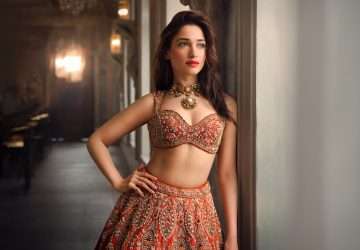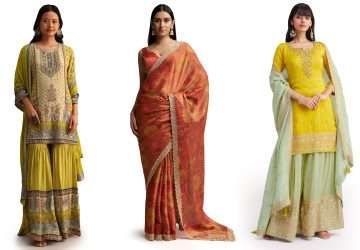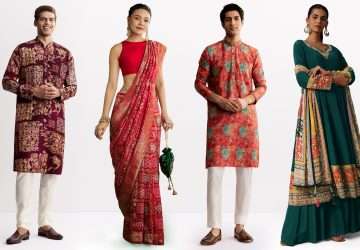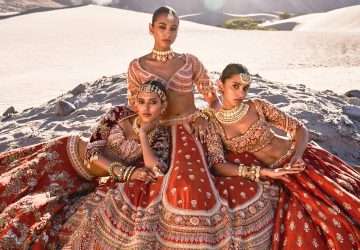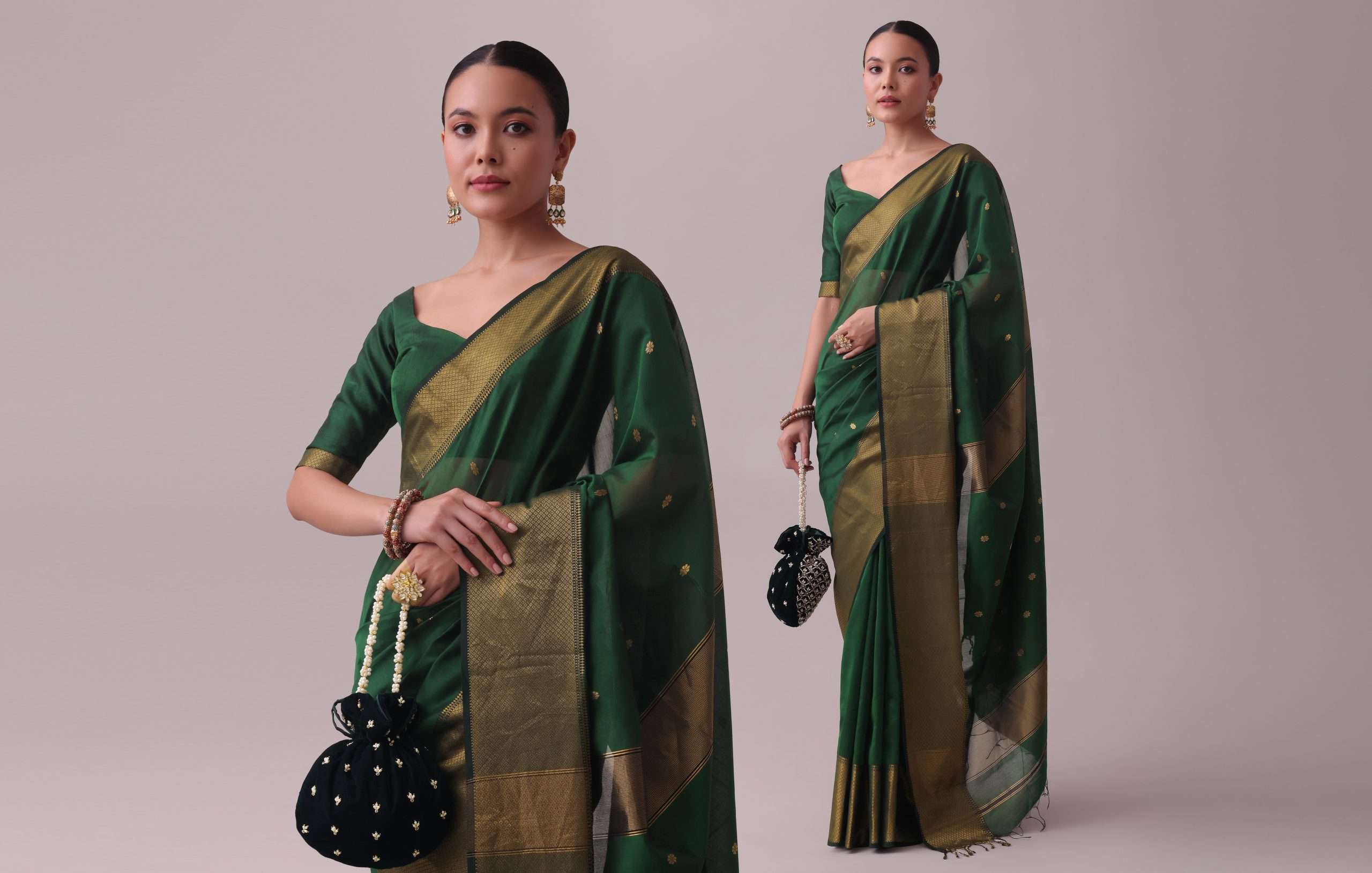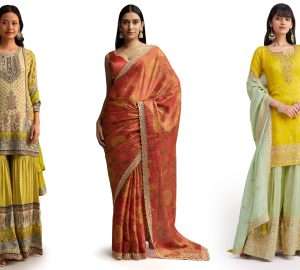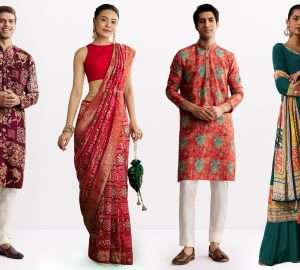South Indian weddings are so colourful with traditions and rituals laced with a dash of modern elegance. But one interesting aspect of these weddings are the colours! Be it the deep red of a bride’s saree, or the golden hues of all that hold the ceremony together, every shade carries a deep meaning in their culture. It’s not just about looking fabulous, it’s about adopting the symbol behind each colour and what it represents on this most important day of your life.
Let’s dive into the significance of colours in South Indian wedding attire, and how you can make these timeless hues work for your modern bridal look.
Importance of Colors in South Indian Wedding Attire
If you have been to a South Indian wedding or even seen a picture of it on Insta you know the wedding colour symbolism plays a HUGE role there. The bridal wear, decoration, and flowers, it’s all such that they convey positivity, prosperity, and happiness. So, it’s a safe bet, these colours aren’t just good to look at; they really bring a lot of power, energy and vibes to the entire ceremony.
Whether you are scrolling through wedding blogs or looking for the right bridal look, knowing the meaning behind these colours will help you appreciate the real spirit of the customs.
Vibrant Hues that Represent Prosperity and Joy
Bright colours basically are the lifeblood of South Indian wedding attire. Let’s talk about the wedding hue meaning that brings joy, energy, and good fortune to the couple. Just think of it, nobody ever leaves a wedding without discussing the beautiful vibrancy of the decoration and clothing.
- Red: This is the quintessential South Indian wedding colour symbolism. Red is like the epitome of passion, fertility, and energy, which is ultimately required by someone to set up a new life. The bride often wears a red saree; which signifies love, commitment, and strength.
- Gold: This is the colour of wealth and divine blessings in the South Indian wedding attire. It’s not a mere add-on; it’s the power play for a bridal look. Talk about gold jewellery, gold-embellished sarees, or golden thali, or what’s commonly referred to as the mangalsutra.
- Yellow: The yellow wedding hue meaning is all about the prosperity and happiness it brings to the house. Often during the marriage ceremony, brides wear yellow-coloured sarees or are draped in yellow flowers indicating prosperity, richness, and well-being.
- Green: The wedding colour symbolism of green is growth, harmony, and life. More often than not, green adorns the person as accessories or flowers or as the bride’s dress to convey a long happy marriage.
Symbolism Behind Traditional Wedding Colors
Now, let’s break it down: why do these colours matter so much? Wedding colour symbolism in South Indian culture is a tradition to be cherished because it is something that not just beautifies but also blesses the couple. Here’s a quick breakdown:
- Red: When we talk about the wedding colour symbolism we think about the most prominent tones used in wedding ceremonies but within these wedding hue meaning lays deep secrets, like the colour red; the true nature of red in South Indian wedding attire is used for protection, this colour is meant to guard the bride against evil spirits, ensuring her new life is filled with protection and love.

- Gold: Hindus believe the South Indian wedding attire is adorned with gold not merely for the shimmer, it goes beyond that, the goddess Lakshmi brings fortune, wealth and prosperity. The wedding colour symbolism is sure to attract the goddess’ blessings, ensuring a life of abundance for the couple.

- Yellow: This wedding colour symbolizes a fresh start and a new life. It’s a staple colour in the many pre-wedding rituals, the yellow colour represents purity and auspicious beginnings.

- Green: Significantly, the colour holds a deep sense of peace and balance to the union, along with a great life of harmonious existence with the spouse. It’s about life and longevity.

Modern Trends in South Indian Bridal Palettes
While traditional colours stand the test of time, there are a few fresh twists in modern South Indian wedding attires embracing colours. Minimalism meets tradition here, as the bride is experimenting with bold colours and sleek, contemporary accessories. Here’s a list of some trends that can be seen:
- Pastel Perfection: Bright colours remain the norm, but pastel shades such as blush pink, mint green, and lavender are increasingly popular. These soft hues paired with gold give a modern, yet equally symbolic, look to the bride.
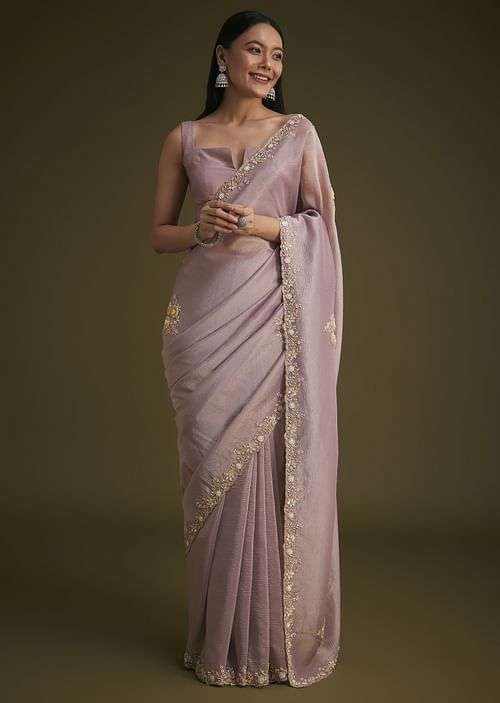
- Metallic Tones: The combination of metallic tones with pastel tones is something that is appearing more and more. Soft, pastel-coloured peaches and baby pinks or lavenders, paired with metallic accents like silver, rose gold, and copper, imbue a new modernity that still keeps up the subtlety of traditional South Indian wedding attires but gives it that contemporary, otherworldly air.
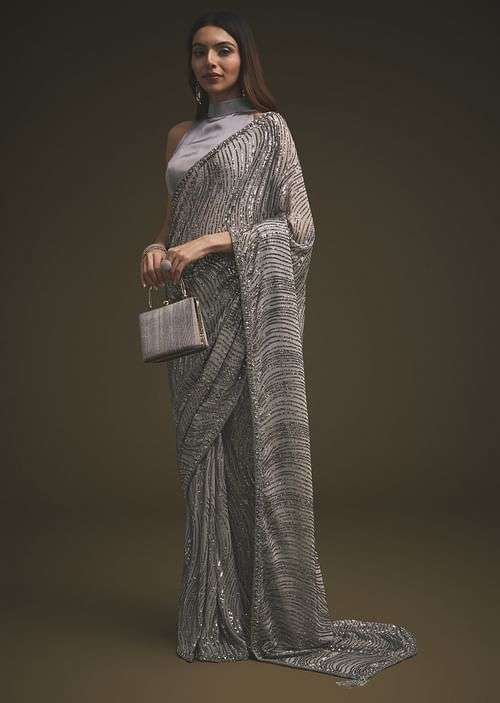
- Wraps of dual-tone colour: The wedding colour symbolizes two colours that blend so perfectly well, such as deep pink transitioning to soft pink or cream-coloured displaying golden hues. The variation brings depth and dimension to the entire ensemble and makes it very beautiful to look at.

- Sustainable Fashion: Sustainability has become the focus and today’s South Indian brides are opting for eco-friendly fabrics, handwoven sarees, and low-profile designs that have reduced carbon foot imprints. Modern brides go for wedding hue meaning as well as starting to use its feel and style, such as organic cotton, khadi, and natural dyes.

- Mixing Fabrics:Now brides incorporate different textures- silk, velvet, and even organza-through their garments that add dimension and depth. An old combination is mixed with something new-a current cut gives freshness and youthful vitality to the ensemble while preserving much of its essence.
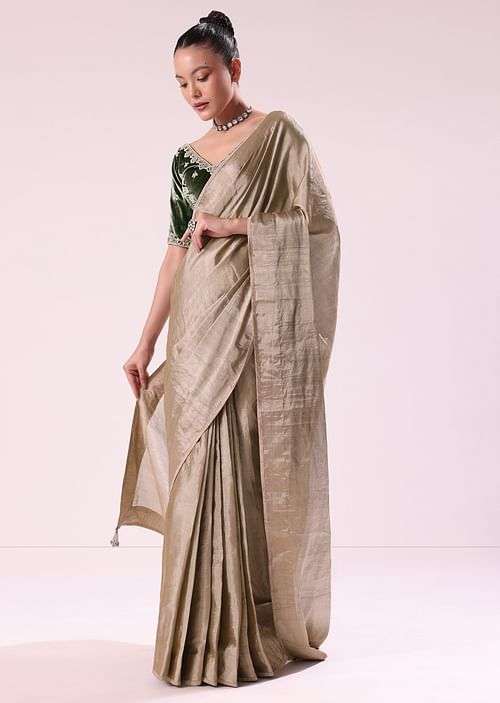
Key Colors and Their Significance
Colours are very symbolic in South Indian wedding attires and play an important role in the celebrations. Wedding color symbolism associated with marriages in South India include red, representing prosperity, fertility, and marital happiness, usually worn by the bride. Yellow represents purity and new love. It is used in rituals, such as during the Haldi ceremony. Green stands for fertility and harmony, while gold reflects wealth and divine blessings.
Other common wedding hues meaning include pink and purple, symbolizing love and affection, with spiritual wisdom as well. Orange is symbolic of joy, while blue is an emblem of peace and stability. Although the bride hardly wears white, the ritualistic usage has been seen for purity and peacefulness. The colors add much cultural depth to South Indian wedding attires and also have a religious implication.
How to Incorporate Traditional Colors into Modern Bridal Looks
Okay, if you wish to carry on this traditional theme with a contemporary twist, here’s how you might go about incorporating these classic South Indian colors into your modern bridal look.
- Saree Choices:If you want to slay the bridal game with the South Indian wedding attire then opt for classic vibrant red or the gorgeous gold silk saree with intricate zari work. For a modern take away go for lighter fabrics like chiffon or georgette with subtle metallic threads or crystal intricacies.
- Jewelry: Layering, another important element in the South Indian wedding attire, layer it with gold jewellery, like bangles, mathapatti, and kamarband that can instantly elevate any bridal look. But don’t be afraid to throw in a pop of color with gem-studded pieces (think rubies, emeralds, and diamonds) to give your outfit a contemporary edge.
- Bridal Accessories: Traditional colors may be incorporated using accessories like a floral hairpiece of marigold, jasmine, or roses, traditional footwear of kalamkari sandals or gold-colored heels, and even a green dupatta or shawl for a chic fusion vibe.
Conclusion: A Colorful, Symbolic Journey
From the deep red of the saree to the golden tinge that illuminates the whole space, there’s a symbolic importance to South Indian wedding attire. They aren’t just tones on a canvas; they symbolise life, love, prosperity, and harmony. As brides weave tradition into their modern selves, these colours will continue telling tales of beauty that are both timelessly cultured and graceful.
So, be it the more traditional red, or pastel and metallic; your South Indian wedding look will be as different as your love story.
FAQs
Why are gold and red dominant in South Indian weddings?
In South Indian wedding ceremonies, the colors gold and red predominate, simply because red connotes prosperity, fertility, and marital bliss. Gold connotes wealth, success, and blessings from God.
What does the color yellow symbolize in South Indian traditions?
Yellow stands for purity in South Indian rituals and auspiciousness and also for a fresh start, that is used more often before marriages in ceremonies, such as in the Haldi ceremony.
How can I add a modern touch to traditional wedding palettes?
You can modernize a traditional wedding color palette by introducing pastel shades, metallic accents, and bold contrasting colors. The pastel colors blended with modern style and cultural elements give the best result.
Are pastels acceptable for South Indian bridal outfits?
Yes, the popularity of blush pink, mint green, and lavender pastels for South Indian bridal outfits has increased as a modern yet elegant take on the traditional outfit.
What jewelry pairs best with traditional South Indian colors?
The best jewelry to go well with traditional South Indian colors such as red, yellow, and green is gold. This increases the cultural richness and symbolizes wealth, prosperity, and divine blessings.
![]()
